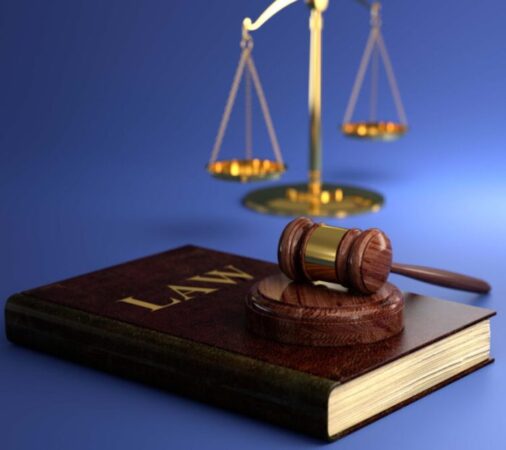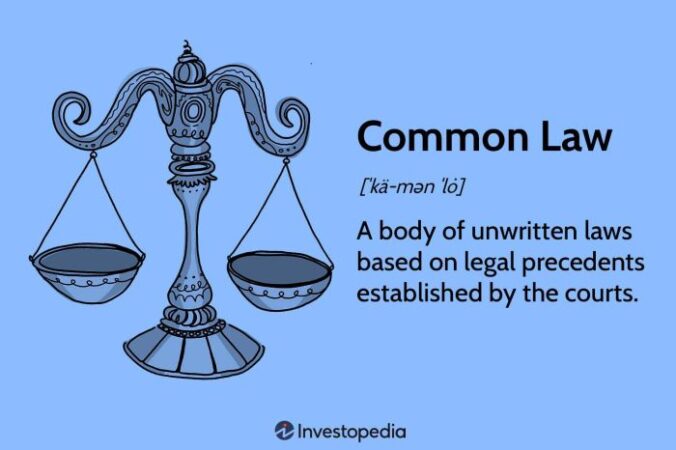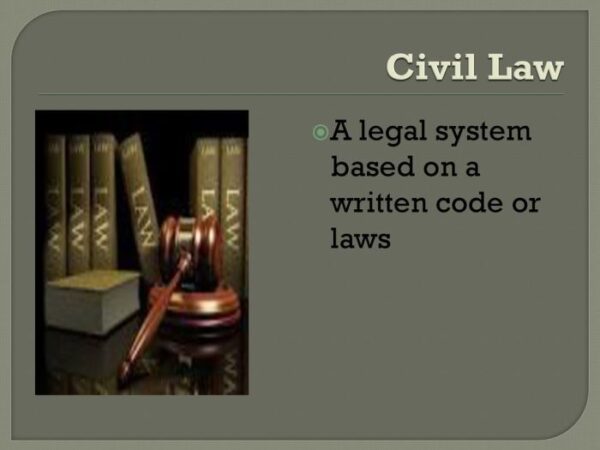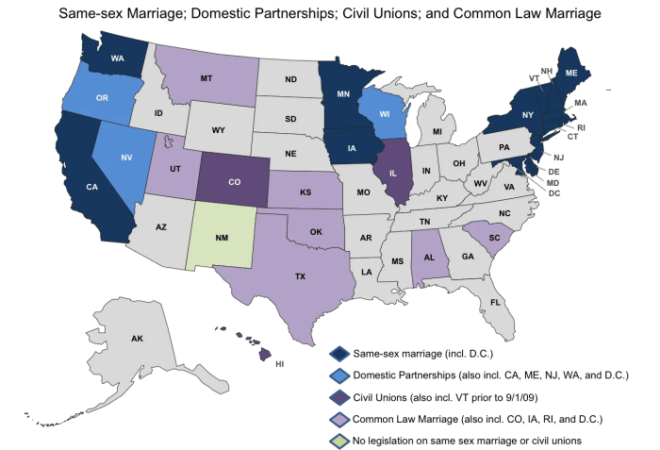
What is the difference between civil and criminal law – What’s the difference between civil and criminal law? This question delves into the heart of our legal system, exploring two distinct branches that govern our lives and interactions. While both systems aim to maintain order and justice, they differ in their fundamental purpose, procedures, and consequences. Imagine a car accident: the driver might face criminal charges for reckless driving, while the injured party could pursue a civil lawsuit for damages. This example highlights the distinct nature of these legal systems, which we’ll explore in detail.
Civil law deals with disputes between individuals, organizations, or entities. It focuses on resolving conflicts and compensating those who have been wronged. On the other hand, criminal law focuses on protecting society by punishing those who violate its rules. It aims to deter future crimes and hold individuals accountable for their actions.
Introduction

Civil and criminal law are two distinct branches of the legal system, each addressing different types of disputes and serving different purposes. Understanding the fundamental differences between these systems is crucial for navigating legal matters effectively.
Civil law governs private disputes between individuals, organizations, or entities. Its primary purpose is to resolve conflicts and provide remedies for harm caused by one party to another. In contrast, criminal law deals with offenses against society as a whole, with the primary aim of protecting public safety and punishing wrongdoers.
Distinguishing Civil and Criminal Matters
To understand the distinction between civil and criminal matters, consider a real-world example: a car accident. If two cars collide, the injured party may file a civil lawsuit against the other driver, seeking compensation for damages such as medical bills, lost wages, and property damage. This is a civil matter because it involves a private dispute between individuals. However, if the police determine that the accident was caused by reckless driving, the driver responsible may face criminal charges, such as reckless endangerment or driving under the influence. This is a criminal matter because it involves a violation of public safety laws.
Civil Law
Civil law governs private rights and obligations between individuals, organizations, or entities. It aims to resolve disputes and provide remedies for wrongs committed against individuals or their property.
Parties Involved in Civil Cases
Civil cases involve two primary parties: the plaintiff and the defendant. The plaintiff is the party who initiates the lawsuit, seeking legal relief from the defendant. The defendant is the party accused of wrongdoing and against whom the plaintiff seeks relief.
Types of Civil Cases, What is the difference between civil and criminal law
Civil cases encompass a wide range of legal disputes, with some common types including:
- Contract Disputes: These cases arise when one party alleges that another party breached a contract, failing to fulfill their obligations. For example, a contractor might sue a homeowner for non-payment for completed work, or a homeowner might sue a contractor for failing to deliver the promised services.
- Property Disputes: These cases involve conflicts over ownership, use, or possession of real estate or personal property. For example, a neighbor might sue another neighbor over a boundary dispute, or a landlord might sue a tenant for unpaid rent.
- Personal Injury Claims: These cases involve claims for damages resulting from physical or emotional harm caused by another person’s negligence or intentional actions. For example, a person injured in a car accident might sue the negligent driver for medical expenses, lost wages, and pain and suffering.
Burden of Proof in Civil Cases
In civil cases, the burden of proof lies with the plaintiff. This means the plaintiff must present sufficient evidence to convince the court that the defendant is liable for the alleged wrong. The standard of proof in civil cases is “preponderance of the evidence,” which means the plaintiff must show that it is more likely than not that the defendant committed the alleged wrong.
Key Elements of Civil Law
| Element | Description |
|---|---|
| Parties | Plaintiff (initiates the lawsuit) and Defendant (accused of wrongdoing) |
| Purpose | To resolve private disputes and provide remedies for wrongs |
| Remedies | Financial compensation (damages), injunctive relief (court orders), specific performance (compelling a party to fulfill a contract), declaratory judgment (court declaration of legal rights) |
Criminal Law
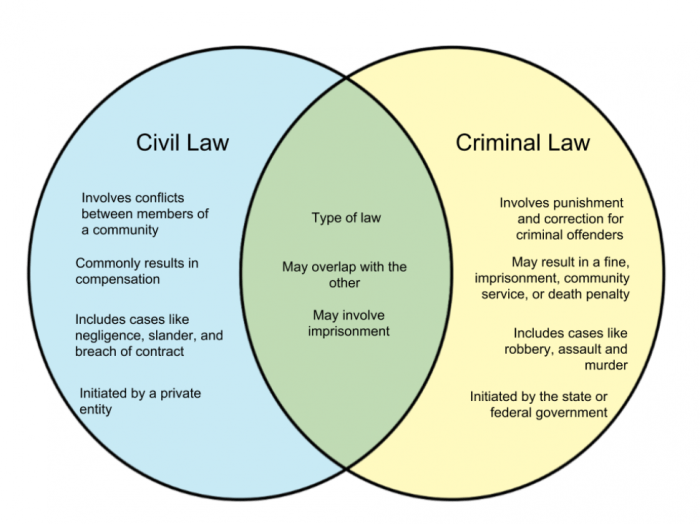
Criminal law is a branch of law that deals with offenses against the state or society as a whole. It aims to maintain public order and safety by punishing individuals who violate established rules and regulations.
Core Principles of Criminal Law
Criminal law is founded on several core principles that guide its application and interpretation. These principles ensure fairness, consistency, and due process in the administration of justice.
- Actus Reus: This principle requires the prosecution to prove that the defendant committed a specific act or omission that is considered a crime. It focuses on the physical element of the crime.
- Mens Rea: This principle refers to the mental state of the defendant at the time of the crime. The prosecution must demonstrate that the defendant acted intentionally, knowingly, recklessly, or negligently.
- Causation: This principle establishes a link between the defendant’s actions and the harm caused. The prosecution must prove that the defendant’s actions directly led to the resulting harm.
- Harm: Criminal law generally requires that the act or omission cause actual harm or potential harm to individuals or society.
Parties Involved in Criminal Cases
Criminal cases involve two primary parties: the prosecution and the defendant.
- Prosecution: The prosecution represents the state or government and has the responsibility of proving the defendant’s guilt beyond a reasonable doubt. The prosecution is typically led by a district attorney or attorney general.
- Defendant: The defendant is the individual accused of committing the crime. They have the right to a fair trial and are presumed innocent until proven guilty.
Types of Criminal Offenses
Criminal offenses are classified based on their severity and potential punishment. The most common classifications are:
- Felonies: These are the most serious crimes, often involving significant harm or violence. They carry substantial penalties, including imprisonment for more than one year.
- Misdemeanors: These offenses are less serious than felonies and typically involve lesser harm or violence. They are punishable by fines or imprisonment for less than one year.
- Infractions: These are minor offenses, often considered violations of rules or regulations. They typically carry only fines as penalties.
Burden of Proof in Criminal Cases
The burden of proof in criminal cases rests on the prosecution. They must prove the defendant’s guilt beyond a reasonable doubt. This means that the jury or judge must be convinced, to a very high degree of certainty, that the defendant committed the crime.
Comparing and Contrasting Civil and Criminal Law
| Criteria | Civil Law | Criminal Law |
|---|---|---|
| Purpose | To resolve disputes between private parties and provide remedies for harm caused. | To maintain public order and safety by punishing individuals who violate established rules and regulations. |
| Parties Involved | Plaintiff (the party bringing the lawsuit) and Defendant (the party being sued). | Prosecution (representing the state) and Defendant (the individual accused of the crime). |
| Burden of Proof | Preponderance of the evidence (more likely than not). | Beyond a reasonable doubt (very high degree of certainty). |
| Remedies | Financial compensation (damages), injunctions, specific performance. | Fines, imprisonment, probation, community service. |
Examples
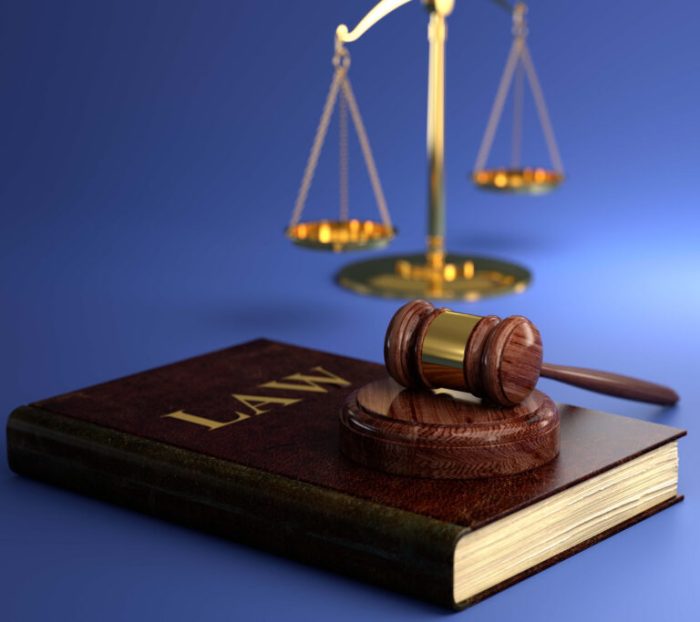
To better understand the difference between civil and criminal law, let’s look at some real-world examples. These examples will illustrate the key differences in the types of cases, the parties involved, and the potential consequences.
Civil Cases
Civil cases involve disputes between individuals, organizations, or entities. The goal of a civil lawsuit is to resolve the dispute and provide a remedy, usually in the form of monetary compensation. Here are a few examples of common civil cases:
- Breach of Contract: Imagine a company hires a contractor to build a new office building. The contractor fails to meet the agreed-upon deadlines and specifications. The company could sue the contractor for breach of contract, seeking damages for the delays and additional costs incurred.
- Personal Injury: A car accident occurs due to the negligence of another driver. The injured party can sue the negligent driver in a personal injury lawsuit, seeking compensation for medical expenses, lost wages, and pain and suffering.
- Property Damage: A neighbor’s tree falls on your property during a storm, causing damage to your house. You can sue your neighbor for property damage, seeking compensation for the repairs.
In civil cases, the burden of proof is on the plaintiff, who must prove their case by a “preponderance of the evidence.” This means that the evidence presented must be more likely than not to support the plaintiff’s claims. If the plaintiff succeeds, the defendant may be ordered to pay damages or perform a specific action.
Criminal Cases
Criminal cases involve actions that are considered harmful to society as a whole. The government, acting on behalf of the people, prosecutes individuals accused of committing crimes. Here are some examples of criminal cases:
- Theft: A person steals a wallet from another individual. The government would prosecute the thief for the crime of theft, which could result in fines, imprisonment, or both.
- Murder: A person intentionally kills another person. The government would prosecute the individual for murder, which carries a severe penalty, including life imprisonment or even the death penalty in some jurisdictions.
- Assault: A person physically attacks another person without justification. The government would prosecute the attacker for assault, which could result in fines, imprisonment, or both.
In criminal cases, the burden of proof is on the prosecution, which must prove the defendant’s guilt “beyond a reasonable doubt.” This is a much higher standard than in civil cases. If the prosecution succeeds, the defendant could face a variety of penalties, including fines, imprisonment, or even the death penalty.
Wrap-Up: What Is The Difference Between Civil And Criminal Law
Understanding the distinction between civil and criminal law is crucial for navigating our complex legal landscape. Whether you’re facing a personal dispute or witnessing a crime, knowing the differences between these systems empowers you to make informed decisions and protect your rights. Remember, the legal system is designed to provide a framework for resolving conflicts and ensuring justice. By understanding its core principles, we can navigate the legal system with confidence and clarity.
Key Questions Answered
What are some examples of civil cases?
Common examples include breach of contract lawsuits, personal injury claims, property disputes, and divorce proceedings.
What are some examples of criminal cases?
Examples include theft, assault, murder, drug trafficking, and fraud.
Can a single event lead to both civil and criminal proceedings?
Yes, a single event can result in both civil and criminal cases. For instance, a car accident could lead to criminal charges for reckless driving and a civil lawsuit for personal injuries.
What is the difference between a plaintiff and a defendant in a civil case?
The plaintiff is the party bringing the lawsuit, while the defendant is the party being sued.
What is the difference between a prosecutor and a defendant in a criminal case?
The prosecutor represents the state or government, while the defendant is the person accused of the crime.
